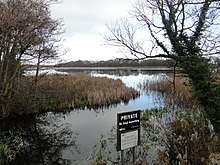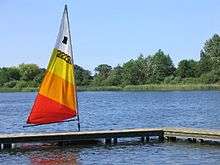Trinity Broads
Trinity Broads is a 316.8-hectare (783-acre) biological Site of Special Scientific Interest north of Great Yarmouth in Norfolk.[1][2] They are in The Broads Special Area of Conservation.[3] They are also part of the Broads National Park in Norfolk, England, comprising 5 broads in total. The three largest are Rollesby Broad, Ormesby Broad and Filby Broad, and there are two much smaller broads named Lily Broad and Ormesby Little Broad.[4] They are managed by the Broads Authority.[5]
| Site of Special Scientific Interest | |
 Filby Broad looking north from the bridge | |
| Area of Search | Norfolk |
|---|---|
| Grid reference | TG 464 149[1] |
| Interest | Biological |
| Area | 316.8 hectares (783 acres)[1] |
| Notification | 1998[1] |
| Location map | Magic Map |
Trinity Broads | ||||||||||||||||||||||||||||||||||||||||||||||||||||||||||||||||||||||||||||||||||||||||||||||||||||||||||||||||
|---|---|---|---|---|---|---|---|---|---|---|---|---|---|---|---|---|---|---|---|---|---|---|---|---|---|---|---|---|---|---|---|---|---|---|---|---|---|---|---|---|---|---|---|---|---|---|---|---|---|---|---|---|---|---|---|---|---|---|---|---|---|---|---|---|---|---|---|---|---|---|---|---|---|---|---|---|---|---|---|---|---|---|---|---|---|---|---|---|---|---|---|---|---|---|---|---|---|---|---|---|---|---|---|---|---|---|---|---|---|---|---|---|
| ||||||||||||||||||||||||||||||||||||||||||||||||||||||||||||||||||||||||||||||||||||||||||||||||||||||||||||||||
The Trinity Broads are on a tributary of the River Bure, but there is no navigable link to the main river system, and they are therefore virtually undisturbed.
Water supply
In 1995, most of the broads were bought by Essex and Suffolk Water, as a means of supplying water to Great Yarmouth. The quality of the water is good, and has been further protected by the construction of a sluice where Muck Fleet meets the River Bure. In order to meet their statutory requirements for conservation and recreation, ESW have formed a partnership with the Broads Authority, the Environment Agency and English Nature. A joint management plan has ensured that recreational use is maintained at a low level and the value of the broads as a wildlife habitat is retained.[6] The level of water in Muck Fleet is lower than that of the River Bure, and water from the channel is pumped into the river by Stokesby pumping station, which is maintained by the internal drainage board.[7]
A project to rectify poor water quality in Ormesby Broad began in 2010. Costing £120,000 over three years, the project involves pumping mud from the bottom of the lake. The mud is rich in nutrients, as a result of agricultural runoff, and removing it increases the capacity of the lake to store water, which is extracted as drinking water, as well as providing better habitat for reedbeds at the edges of the lake. Twelve lagoons were prepared to hold the mud until it dried, but initial archaeological investigation of the site for the lagoons revealed the presence of a Middle Bronze Age field system, the first such system found to the east of the Cambridgeshire Fens. The start of pumping was delayed while the site was investigated. Pumping began in March 2010, but was delayed again when live ammunition was sucked up in the mud, and became trapped in the pumps.[8]
By mid-May, pumping had to stop, due to the rapid growth of aquatic plants. It resumed in August, and by early 2011, around 20,000 cubic yards (15,000 m3) had been removed.[9] Once the mud has dried, the nutrients in it make it good for fertilising poor-quality soil, and it is ploughed in. When completed, around twice this volume of mud will have been removed from the bottom of the broad.[8]
Recreation

No motor boats are allowed onto the Trinity Broads, although rowing boats and dinghies are available for hire. Muck Fleet, which connects the broads to the River Bure, is too shallow even for such craft.[10]
Besides sailing, the broads are also very popular with anglers. Recently, new facilities for disabled people have been created, including a special platform for anglers in wheelchairs. Ormesby Little Broad is used for sailing model yachts, and the Norfolk Model Yacht Club have an arrangement with Essex and Suffolk Water, which allows them to use the broad for this purpose once a month. Like their larger counterparts, the use of petrol or oil engines is not permitted, and all remote control is therefore by electric motors.[11]
Bibliography
- Cumberlidge, Jane (2009). Inland Waterways of Great Britain (8th Ed). Imray Laurie Norie and Wilson. ISBN 978-1-84623-010-3.CS1 maint: ref=harv (link)
References
- "Designated Sites View: Trinity Broads". Sites of Special Scientific Interest. Natural England. Retrieved 21 June 2018.
- "Map of Trinity Broads". Sites of Special Scientific Interest. Natural England. Retrieved 21 June 2018.
- "Designated Sites View: The Broads". Special Areas of Conservation. Natural England. Retrieved 25 May 2018.
- Ordnance Survey (2005). OS Explorer Map OL40 - The Broads. ISBN 0-319-23769-9.
- "Trinity Broads, Introduction". The Broads Authority. Archived from the original on 18 July 2011. Retrieved 13 March 2010.
- "Trinity Broads". Essex and Suffolk Water. Archived from the original on 3 October 2010. Retrieved 13 March 2010.
- "Trinity Broads management plan" (PDF). p. 14. Archived from the original (PDF) on 18 July 2011. Retrieved 13 March 2010.
- "Mud pumping project at Ormesby Broad". Essex and Suffolk Water. Archived from the original on 1 October 2011. Retrieved 2011-08-31.
- "Trinity Broads News" (PDF). Trinity Broads Partnership. May 2011.
- Cumberlidge 2009, p. 225
- Trinity Broads management plan, p20
| Wikimedia Commons has media related to Trinity Broads. |